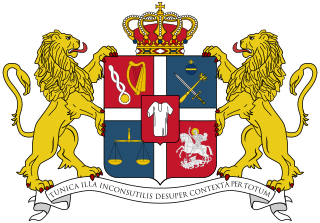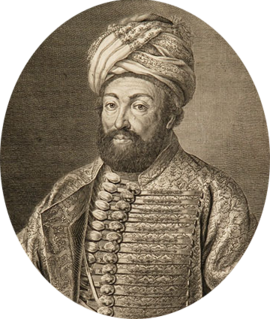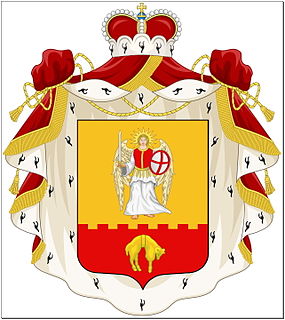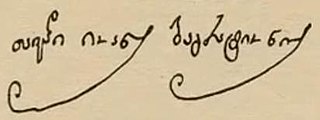Constantine III (Georgian :კონსტანტინე III მუხრანბატონი, Konstantine III Mukhranbatoni) (1696 – 26 October 1756) was a Georgian prince and the head of the Mukhrani branch of the royal Bagrationi dynasty of Kartli. He was Prince ( batoni ) of Mukhrani and ex officio commander of the Banner of Shida Kartli and Grand Master of the Household (msakhurt-ukhutsesi) at the court of Kartli from 1735 and 1756.

Georgian is a Kartvelian language spoken by Georgians. It is the official language of Georgia. Georgian is written in its own writing system, the Georgian script. Georgian is the literary language for all regional subgroups of Georgians, including those who speak other Kartvelian languages: Svans, Mingrelians and the Laz.

Georgia is a country in the Caucasus region of Eurasia. Located at the crossroads of Western Asia and Eastern Europe, it is bounded to the west by the Black Sea, to the north by Russia, to the south by Turkey and Armenia, and to the southeast by Azerbaijan. The capital and largest city is Tbilisi. Georgia covers a territory of 69,700 square kilometres (26,911 sq mi), and its 2017 population is about 3.718 million. Georgia is a unitary semi-presidential republic, with the government elected through a representative democracy.

The House of Mukhrani is a Georgian family, a branch of the former royal dynasty of Bagrationi from which it sprang early in the 16th century, and received in appanage the domain of Mukhrani located in Kartli, central Georgia. The family has since been known as Mukhran-Batoni, that is, "Princes (batoni) of Mukhrani".
Constantine was a military commander under his suzerains, Georgian kings Teimuraz II and Heraclius II. He served as a governor ( mouravi ) of Tbilisi. As a measure against the marauding Lesgian raids, he fortified the fortresses of Ksani, Mchadijvari, and Shiosubani. In 1749, he took part in a successful military expedition undertaken by the Georgian kings to defend the Erivan Khanate from the Turkic Tarakama tribe. From 1754 to 1755, he was involved in the defense of Georgia's frontier from the Avar Khanate. He was killed in a clash with the Lesgians in 1756 and interred at the Cathedral of Mtskheta. Since his sons were still in their minority, Constantine's titles and properties passed on to his family member, Simon. [1] [2]

Teimuraz II (1680/1700–1762) of the Bagrationi dynasty, was a king of Kakheti, eastern Georgia, from 1732 to 1744, then of Kartli from 1744 until his death. Teimuraz was also a lyric poet.

Heraclius II, also known as Erekle II and The Little Kakhetian, was a Georgian monarch of the Bagrationi dynasty, reigning as the king of Kakheti from 1744 to 1762, and of Kartli and Kakheti from 1762 until 1798. In the contemporary Persian sources he is referred to as Erekli Khan, while Russians knew him as Irakly (Ираклий). His name is frequently transliterated in a Latinized form Heraclius because both names Erekle and Irakli are Georgian versions of this Greek name.
Mouravi was an administrative and military officer in early modern Georgia, translated into English as seneschal, bailiff, or constable. A mouravi was an appointed royal official who had a jurisdiction over particular town or district. In towns, the mouravi was assisted by a police officer, natsvali. The best-known mouravi in Georgian history was Giorgi Saakadze, called "the Grand Mouravi."

